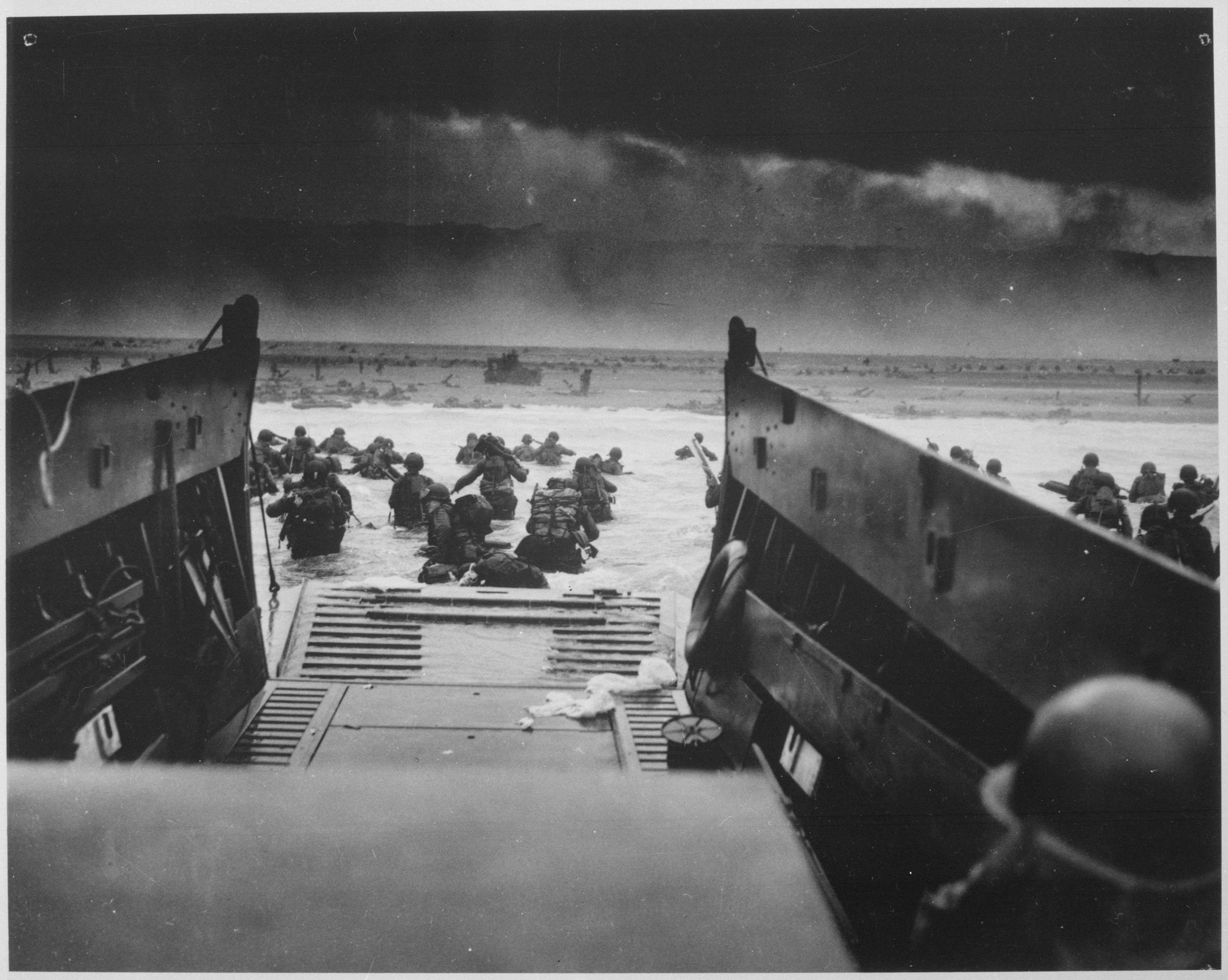Comparing D-Day Photographs
Focusing on Details: Compare and Contrast
All documents and text associated with this activity are printed below, followed by a worksheet for student responses.Introduction
You will learn about the 320th Barrage Balloon Battalion, the only African American combat unit to land on the Normandy beaches during D-Day, and the important role these soldiers played in providing aerial protection during and after this amphibious assault.
Examine the photographs closely and answer the questions. Click on “View the Entire Document” to see the images in greater detail.
Name:
Class:
Class:
Worksheet
Comparing D-Day Photographs
Focusing on Details: Compare and Contrast
Examine the documents included in this activity and write your response in the space provided.

- What details stand out to you from the two photographs? People, objects, activities, etc.?
- What do you see that is the same in the two photographs?
- What do you see that is different in the two photographs?
Your Response
1
Activity Element
Landings at Omaha beach during Normandy Invasion

2
Activity Element
Photograph of the French Invasion Beach

Conclusion
Comparing D-Day Photographs
Focusing on Details: Compare and Contrast
- What do we learn about the D-Day invasion by comparing the two photographs?
- What questions do the photographs raise? What questions do the photographs not answer?
- How do these photographs connect to or challenge your understanding of heroism as it relates to D-Day?
Your Response
Document
Landings at Omaha beach during Normandy Invasion
6/6/1944
Entitled "Into the Jaws of the Death" by the Coast Guard, the original caption for this iconic photo reads:
Because of the tides, the attacks on the beaches were not simultaneous. The first took place at 04:55 at Utah, followed by Omaha, Gold, Juno, and ending at Sword at 07:25. None of the Allies’ first-day objectives had been achieved on June 6, and they suffered heavy casualties. An estimated 10,000 were killed, wounded, or missing in action. 6,603 were Americans, 2,700 British, and 946 Canadians.
The overall goal was to establish a position that would allow for the liberation of Western Europe before marching onward to Berlin. More than two months later, Paris was liberated on August 25, 1944. Eventually the Allied armies made their way to Berlin and victory in Europe was achieved by May 8, 1945.
"Down the ramp of a Coast Guard Landing barge Yankee soldiers storm toward the beach-sweeping fire of Nazi defenders in the D-Day Invasion of the French Coast. Troops ahead may be seen lying flat under the deadly machine gun resistance of the Germans. Soon the Nazis were driven back under the overwhelming Invasion forces thrown in from Coast Guard and Navy amphibious craft."June 6, 1944 was D-Day, one of the most well-remembered moments of World War II. On that day American, British, and Canadian forces stormed the 50-mile stretch of coastline in northwest France in the largest seaborne invasion in history. 150,000 troops, 7,000 ships, and over 13,000 aircraft were involved. 24,000 soldiers descended by air, the rest by sea. The beach along the 50-mile coastline was split into groups: Utah, Omaha, Gold, Juno, and Sword.
Because of the tides, the attacks on the beaches were not simultaneous. The first took place at 04:55 at Utah, followed by Omaha, Gold, Juno, and ending at Sword at 07:25. None of the Allies’ first-day objectives had been achieved on June 6, and they suffered heavy casualties. An estimated 10,000 were killed, wounded, or missing in action. 6,603 were Americans, 2,700 British, and 946 Canadians.
The overall goal was to establish a position that would allow for the liberation of Western Europe before marching onward to Berlin. More than two months later, Paris was liberated on August 25, 1944. Eventually the Allied armies made their way to Berlin and victory in Europe was achieved by May 8, 1945.
This primary source comes from the Records of the U.S. Coast Guard.
National Archives Identifier: 513173
Full Citation: Landings at Omaha beach during Normandy Invasion; 6/6/1944; Photographs of Activities, Facilities, and Personalities, 1939 - 1967; Records of the U.S. Coast Guard, ; National Archives at College Park, College Park, MD. [Online Version, https://docsteach.org/documents/document/landings-at-omaha-beach-during-normandy-invasion, May 16, 2024]Landings at Omaha beach during Normandy Invasion
Page 1

Document
Photograph of the French Invasion Beach
1944
Original caption: "Supplies Pour Ashore for Invaders of France. This striking panorama of the French invasion beach was made by a Coast Guard Combat Photographer from a hillside out with the trenches (foreground) of the ousted Nazi defenders. The channel waters are black with shipping, as reinforcements and supplies are funneled ashore for the conquest of the Cherbourg Peninsula. Balloon barrages float overhead to protect the ships from low-flying enemy strafers. One balloon rests on the deck of an LST. Headed inland are long parades of trucks, loaded with troops and supplies."
This primary source comes from the Records of the U.S. Coast Guard.
National Archives Identifier: 205578630
Full Citation: 26-G-2517; Photograph of the French Invasion Beach; 1944; Europe - Normandy Invasion; Photographs of Activities, Facilities, and Personalities, 1939–1967; Records of the U.S. Coast Guard, ; National Archives at College Park, College Park, MD. [Online Version, https://docsteach.org/documents/document/photograph-french-invasion-beach, May 16, 2024]Photograph of the French Invasion Beach
Page 1

